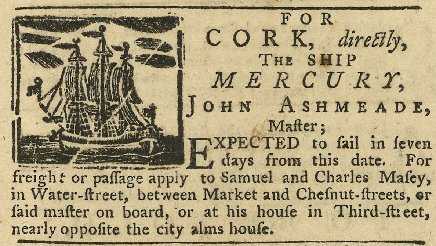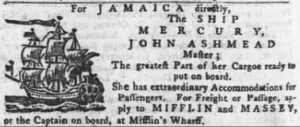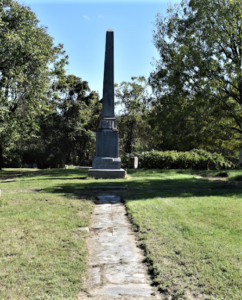Title: Ship Captain, Revolutionary War; mariner
Birthdate: September 29, 1738
Death Date: June 6, 1818
Plot Location: Section 112, First Baptist Church plot

The Ashmead family came from Cheltenham, England in 1682 and settled in what is now Cheltenham in Montgomery County, PA. John Ashmead was born in Germantown, PA, the son of John and Ann Rush Ashmead. Descended from three generations of farmers, John received a good education and chose to forego farming for life in Philadelphia.
He secured a clerk position at the mercantile house of Benjamin Mifflin, who also owned a ship, the New York. Sensing the young man’s restlessness, Mifflin thought the 19-year-old should pursue his dream of going to sea. John’s interest in Mr. Mifflin’s 16-year-old daughter, Mary, might have also been why he encouraged John be a mariner. Mary was also the niece of Governor Thomas Mifflin, first Governor of the Commonwealth of Pennsylvania. John did pursue Mary, however, and she became his bride in 1761. They had nine children and 53 years of married life.
During the French and Indian War the New York sat at harbor due to an embargo on outgoing ships. British Commander Major General Abercromby was planning an attack on a French fort on Lake Champlain and didn’t want his movements disclosed. Months into the embargo, shippers, merchants, and crews were becoming restless.
The New York‘s captain, Edward Walsh, decided, with Mr. Mifflin’s implicit approval, to run the embargo. He set sail for St. Croix, West Indies, with young John Ashmead serving as “super cargo.” The super cargo serves aboard the vessel, is employed by and represents the owner of the merchant ship by overseeing the cargo, selling merchandise in ports and buying goods for the return to home port. This was the first voyage of John’s long, record-setting career as a mariner. He would log more than 100 voyages in his lifetime and spend more than 30 years of his married life at sea.
The image above was an advertisement for freight and passage aboard the Mercury, with John as captain. It appeared in the September 19, 1765, issue of the Pennsylvania Journal. This ad for a trip to Jamaica was from the same time period.
Mercury, with John as captain. It appeared in the September 19, 1765, issue of the Pennsylvania Journal. This ad for a trip to Jamaica was from the same time period.
John’s participation in the Revolution began in January of 1776. The Continental Congress had appointed a Marine Committee and authorized the building of thirteen frigates, which were warships built for speed and maneuverability. The committee then selected commissioners to oversee the construction, and these commissioners appointed John as clerk in the Wharton & Humphreys shipyard. Frigate #2 (later named the Randolph) was under construction and John’s daily duties included keeping time records, hiring labor, and doing whatever was needed to assist the builders.
During this time John also joined Captain Joseph Cowperthwait’s militia. The group was known as the Quaker Light Infantry because it was composed of Quakers or descendants of Quakers. Although John was a Baptist, he was descended from Quakers. When the militia was called to Trenton for the defense of New Jersey, John was exempted when the Committee requested he not be sent due to his “necessary business” in the shipyard. During the Revolution, John captained the ship “Mars,” the brig “Eagle,” and other vessels of the Pennsylvania navy from 1777-1782, and was engaged in action with various British privateers in 1779.
The years after the Revolution found John continuing the seafarers life. A constant succession of ships and travels to locations, both exotic and domestic kept him busy. In 1784 the China trade opened to American ships and John became the sixth Philadelphia skipper to undertake the arduous voyage. His ship, the Union, cleared port on March 22, 1789 and after 180 days and 17,150 miles reached its destination of Canton. He would return home 5 months later with a full cargo of teas, silks and chinaware.
John’s final voyage ended on April 8, 1805 and he returned to his home on Sansom Street. Although no longer sailing the seas, the Captain remained involved in the sailing, shipping and merchant trades. His knowledge, skill and sense of discipline would contribute to his success on land as well. In 1806 he was appointed by Governor McKean as assistant warden of the Port of Philadelphia. The Board of Port Wardens consisted of a master warden and 6 assistants. They were in charge of navigation in the Delaware. In 1809, he was “appointed and commissioned” by Governor Snyder to the position of Master Warden of the Port of Philadelphia.
Captain John Ashmead died four years after his wife and was buried in the First Baptist Church’s burial ground on the south side of the 200 block of Arch  Street. When the church moved in 1855, it was decided to purchase a large plot at the new Mount Moriah cemetery and the 3000 graves were supposed to be re-interred. This is a photo of Section 112, showing how the gravestones from the church yard were placed here as a path to the church’s memorial obelisk.
Street. When the church moved in 1855, it was decided to purchase a large plot at the new Mount Moriah cemetery and the 3000 graves were supposed to be re-interred. This is a photo of Section 112, showing how the gravestones from the church yard were placed here as a path to the church’s memorial obelisk.
Construction crews at the Arch Street site in 2016 discovered that the job of relocating the graves was never finished, probably because the Philadelphia Board of Health only gave them three months in the middle of winter to do it. A team of scientists headed by the Mütter Museum collected about 700 remains, which were studied under the title, The Arch Street Project. The remains are to be buried here with their fellow church members.

Support the Friends of Mount Moriah
Help us in our mission to restore and maintain the beautiful Mount Moriah Cemetery by donating to our cause or volunteering at one of our clean-up events.

